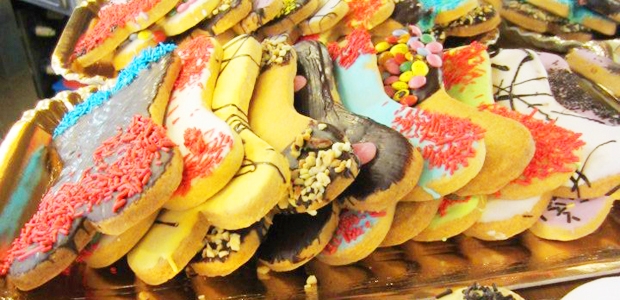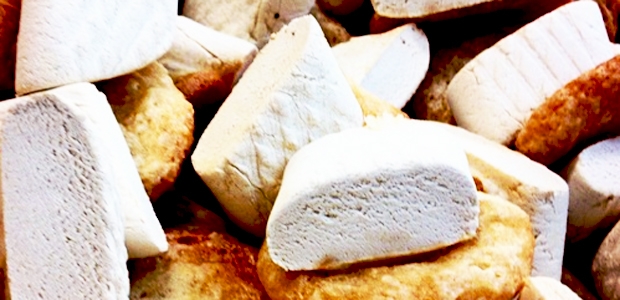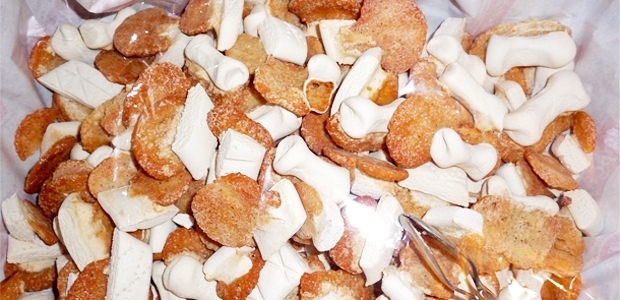Languages
Bones of the Dead: the afterlife sweet worship
Day of the Dead Parmesan delicacy between kitchen and tradition: a dialogue with the afterlife comes to Sicily
Ma perché pria del tempo a sé il mortale Inviderà l’illusïon che spento Pur lo sofferma al limitar di Dite?
From the poet Ugo Foscolo to the table, the cult of the dead has a long history and not only in literature.With a bleak name but with a delicious taste, in the Italian folk scene, the “Bones of the Dead” are the typical autumnal sweets prepared for the Feast of All Hallows. Decorated sweets in shortcrust pastry, the “Bones” are the symbol of a dialogue with the dead shared by a lot of Italian Peninsula tables. Mysticism or pure handed down tradition? Why deny yourself the pleasure of sweet illusion?
Ossa dei morti, Òs äd mort, crozzi ‘i mottu and mustazzuòli: those sweets are popular mainly in Parma and in Sicily, but also in Montepulciano, Montalcino, Piedmont and Lombardy.
Round, friable and decorated, or elongated and crisp, the “Bones of the Dead” are homemade sweets, in the past they were made also in religious convents, based on ingredients that today we define poor, but at one time, at least until the nineteenth century, were privilege of the rich and religious.
Flour, sugar and cinnamon, the three common elements that we find in almost all the regional variations.
Their preparation requires 2 to 4 days of work: hence the ritual patient that creates a food suspended between the sacred and the profane. Is typical, in all the italian regions, the union of sweet taste with spicy flavor of cinnamon or cloves, and often with almonds and dried fruit, as in Piedmont, where the sweets are served with a sweet wine naturally.
Typically Parmesan, the “Bones of the Dead” are prepared with the addition of chopped almonds, giving an elongated bone-like (many “rezdore”-parmesan housewives still give shapes that recall the various “bones”). Curious is the use of this sicilian ingredient, also in the recipes of the famous “Scarpette di Sant’Ilario”, dedicated on January 13 to the patron of the ducal city, and beans of the dead: pastries made with almonds and lemon peel that, before favism, were cooked with dried fava beans, considered for its long roots a connection with the afterlife.
In the Marche and in some places in Sicily, until a few years ago the roads leading to the cemeteries were dotted with stands selling the delicious almond sweets.
From North to South: the cult of the dead seems linked to a few but essential "magic" ingredients, considered redeeming or sacrificed, in ancient times as a food products of the earth and man, to ingratiate with the divine forces otherworldly.
Parmigian recipe
Ingredients
- 200g ground almonds
- 200g of sugar
- 30g butter
- 200g flour
- 3 cloves chopped
- 1 pinch of cinnamon powder
- 1 egg plus two egg whites
- Grated lemon peel
For the glaze
- 200g icing sugar
- The juice of ½ lemon
- 30g egg whites
- A pinch of vanilla extract
Mix all the ingredients in order to obtain a homogeneous and compact dough; spread with the help of a rolling pin until it reaches the thickness of ½ cm. Pour the mixture into a tray, cover with plastic wrap and leave in the refrigerator for a whole day. The next day, cut the dough to give the classic form of the “bone”. Place the shapes on a greased baking sheet and bake in preheated oven at 170 degrees for 20 minutes.
For the glaze: mix the ingredients and turn them into a thick cream that you will use to decorate the cake, along with chocolate sprinkles or colored sprinkles.
In the variant of Sicily, the cakes decorated piece by piece and engraved with a little knife, are left to dry for two days (in ancient time in the sun). Once hardened, they are extracted from the respective molds and wet at the bottom with a little bit of water. Subsequently they have to be cooked in the oven at 160 ° for 20 minutes. Once ready, the white base caramelized cookie reaches the typical hard surface whitish.
Curiosity and tradition
Food between sacred and profane. Throughout in Italy for Day of the Dead is used to prepare sweets and delicacies that have common origins, mostly propitiatory, sometimes magical and apotropaic, to appease the souls and receive from them prosperity.
Since ancient times, it was believed that men and were made of the same substance. Expression of what was a convivial community that used the meal to connect with the afterlife. L’Ovidio dei Fasti said:
Mos erat, et mensae credere adesse Deos
A Widespread popular belief is that the souls of the loved ones, the night before November 2, returned to the earth: so the homes table remained set for the whole night, with water and sweets, to allow the family "on the road "to refresh.
But often, because of that otherness between living and dead, it was thought that the dead themselves were leaving gift of treats, especially for children.
In Sicily, a popular legend tells that the dead come down in their earthly city to steal the sweets to the richer pastries and take them to the small home, so today it is custom to cook sweets to give to the children.
From this tradition, we mantain the educational use of the treats of the dead: to preapare the little ones to the inevitable arrival of death, acting as a bridge between the earthly world and the hereafter. A lot of people, probably for the difficult task to which they were called upon to accomplish, considered the “bones” “magic cookies”.
But, together with the fables, there are those who leads the custom of "Bones dead" in a symbolic “patrofagia”, dating from the Middle Ages (at that time they used the powder of the skull to flavor food or to make love potions); from this pespective the combination of hardness-bones and the parmesan expression “Os da mord”, cause eating the cookie seems to bite a bone.
Shapes, textures and colors: the bones from dead remain the symbol of a sweet food conviviality between the living and the dead; a poor and magical food that, at least once a year, combines the memory of death to gentle way of life.







